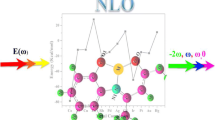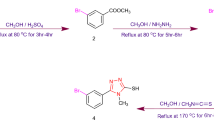Abstract
The electronic properties, absorption spectra, and nonlinear optical properties of triamantane substituted with alkali metals were investigated. Upon the substitution of triamantane via alkali metals affect the absorption capacity drastically that also reflect form EHOMO-ELUMO (H–L) gap. Compared to triamantane, which has H–L gap of 9.06 eV, the designed molecule 9 has the H–L gap (3.474 eV). Alkali metal substitution at different position in triamantane reviled that specific position is important for enhancing the first order hyperpolarizability (βtot) value. Out of different molecules, 9 has a highest first hyperpolarizability among the designed molecules. Calculated results reviled that the lower crucial transition energy (ΔE = 1.648 eV) is responsible for the significant increase in first hyperpolarizability (βtot). We have also calculated frontier molecular orbitals (FMO), transition density matrix (TDM), and densities of states (DOS) at same level of the theory. The absorption shifts from ultraviolet to visible was observed when triamantane was substituted via alkali metal. It is also observed form spectra that as the size of the alkali metal atoms increases the red shift takes place.







Similar content being viewed by others
Code availability
We have used Gaussian 16 and multiwfn 3.8 software.
References
Eaton DF (1991) Nonlinear optical materials. Science 253:281–287
Bredas JL, Adant C, Tackx P, Persoons A, Pierce BM (1994) Third-order nonlinear optical response in organic materials: theoretical and experimental aspects. Chem Rev 94:243–278
Marder SR, Torruellas WE, Blanchard-Desce M, Ricci V, Stegeman GI, Gilmour S, Bredas J-L, Li J, Bublitz GU, Boxer SG (1997) Large molecular third-order optical nonlinearities in polarized carotenoids. Science 276:1233–1236
Nakano M, Fujita H, Takahata M, Yamaguchi K (2002) Theoretical study on second hyperpolarizabilities of phenylacetylene dendrimer: Toward an understanding of structure- property relation in NLO responses of fractal antenna dendrimers. J Am Chem Soc 124:9648–9655
Oudar J-L, Chemla DS (1977) Hyperpolarizabilities of the nitroanilines and their relations to the excited state dipole moment. J Chem Phys 66:2664–2668
Van Cleuvenbergen S, Asselberghs I, Garcia-Frutos EM, Gomez-Lor B, Clays K, Perez-Moreno J (2012) Dispersion overwhelms charge transfer in determining the magnitude of the first hyperpolarizability in triindole octupoles. J Phys Chem C 116:12312–12321
Blanchard-Desce M, Alain V, Bedworth PV, Marder SR, Fort A, Runser C, Barzoukas M, Lebus S, Wortmann R (1997) Large quadratic hyperpolarizabilities with donor–acceptor polyenes exhibiting optimum bond length alternation: correlation between structure and hyperpolarizability. Chem Eur J 3:1091–1104
Coe BJ, Jones LA, Harris JA, Brunschwig BS, Asselberghs I, Clays K, Persoons A (2003) Highly unusual effects of π-conjugation extension on the molecular linear and quadratic nonlinear optical properties of ruthenium (II) ammine complexes. J Am Chem Soc 125:862–863
Geskin VM, Lambert C, Brédas J-L (2003) Origin of high second-and third-order nonlinear optical response in ammonio/borato diphenylpolyene zwitterions: the remarkable role of polarized aromatic groups. J Am Chem Soc 125:15651–15658
Xu H-L, Li Z-R, Wu D, Wang B-Q, Li Y, Gu FL, Aoki Y (2007) Structures and large NLO responses of new electrides: Li-doped fluorocarbon chain. J Am Chem Soc 129:2967–2970
Champagne B, Plaquet A, Pozzo J-L, Rodriguez V, Castet F (2012) Nonlinear optical molecular switches as selective cation sensors. J Am Chem Soc 134:8101–8103
Zhong R-L, Zhang J, Muhammad S, Hu Y-Y, Xu H-L, Su Z-M (2011) Boron/nitrogen substitution of the central carbon atoms of the biphenalenyl diradical π dimer: A novel 2e–12c bond and large NLO responses. Chem - Eur J 17:11773–11779
Wu H-Q, Zhong R-L, Kan Y-H, Sun S-L, Zhang M, Xu H-L, Su Z-M (2013) After the electronic field: Structure, bonding, and the first hyperpolarizability of HArF. J Comput Chem 34:952–957
Karamanis P, Pouchan C (2012) Fullerene–C60 in contact with alkali metal clusters: prototype nano-objects of enhanced first hyperpolarizabilities. J Phys Chem C 116:11808–11819
Koukaras EN, Zdetsis AD, Karamanis P, Pouchan C, Avramopoulos A, Papadopoulos MG (2012) Structural and static electric response properties of highly symmetric lithiated silicon cages: Theoretical predictions. J Comput Chem 33:1068–1079
Chen W, Li Z-R, Wu D, Li Y, Sun C-C, Gu FL (2005) The structure and the large nonlinear optical properties of Li@ Calix [4] pyrrole. J Am Chem Soc 127:10977–10981
Muhammad S, Xu H, Liao Y, Kan Y, Su Z (2009) Quantum mechanical design and structure of the Li@ B10H14 basket with a remarkably enhanced electro-optical response. J Am Chem Soc 131:11833–11840
Kumar R, Yadav SK, Seth R, Singh A (2022) Designing of gigantic first-order hyperpolarizability molecules via joining the promising organic fragments: a DFT study. J Mol Model 29:5
Yadav SK, Bhunia S, Kumar R, Seth R, Singh A (2023) Designing Excess Electron Compounds by Substituting Alkali Metals to a Small and Versatile Tetracyclic Framework: A Theoretical Perspective. ACS Omega 8:7978–7988
Muhammad S, Xu H-L, Zhong R-L, Su Z-M, Al-Sehemi AG, Irfan A (2013) Quantum chemical design of nonlinear optical materials by sp 2-hybridized carbon nanomaterials: issues and opportunities. J Mater Chem C 1:5439–5449
Xu H-L, Zhong R-L, Sun S-L, Su Z-M (2011) Widening or lengthening? Enhancing the first hyperpolarizability of tubiform multilithium salts. J Phys Chem C 115:16340–16346
Xu H-L, Li Z-R, Wu D, Ma F, Li Z-J, Gu FL (2009) Lithiation and Li-doped effects of [5] cyclacene on the static first hyperpolarizability. J Phys Chem C 113:4984–4986
Hu Y-Y, Sun S-L, Muhammad S, Xu H-L, Su Z-M (2010) How the number and location of lithium atoms affect the first hyperpolarizability of graphene. J Phys Chem C 114:19792–19798
Wu H-Q, Zhong R-L, Sun S-L, Xu H-L, Su Z-M (2014) Alkali metals-substituted adamantanes lead to visible light absorption: large first hyperpolarizability. J Phys Chem C 118:6952–6958
Srivastava A, Mishra R, Kumar S, Dev K, Tandon P, Maurya R (2015) Molecular structure, spectral investigation (1H NMR, 13C NMR, UV–Visible, FT-IR, FT-Raman), NBO, intramolecular hydrogen bonding, chemical reactivity and first hyperpolarizability analysis of formononetin [7-hydroxy-3 (4-methoxyphenyl) chromone]: A quantum chemical study. J Mol Struct 1084:55–73
Mahmood A, Khan SU-D, Rana UA, Janjua MRSA, Tahir MH, Nazar MF, Song Y (2015) Effect of thiophene rings on UV/visible spectra and non-linear optical (NLO) properties of triphenylamine based dyes: a quantum chemical perspective. J Phys Org Chem 28:418–422
Sun W-M, Li X-H, Wu J, Lan J-M, Li C-Y, Wu D, Li Y, Li Z-R (2017) Can coinage metal atoms Be capable of serving as an excess electron source of alkalides with considerable nonlinear optical responses? Inorg Chem 56:4594–4600
Srivastava AK (2021) Lithiated graphene quantum dot and its nonlinear optical properties modulated by a single alkali atom: A theoretical perspective. Inorg Chem 60:3131–3138
Wang Y-F, Wang J-J, Li J, Liu X-X, Wang Z-J, Huang J, Li Z-R (2021) From an electride-like super alkali earth atom to a superalkalide or superalkali electride: M(HF)3M (M= Na or Li) as field-induced excellent inorganic NLO molecular switches. J Mater Chem C 9:14885–14896
Hou J, Jiang D, Qin J, Duan Q (2018) Alkaline-earthide: a new class of excess electron compounds Li-C6H6F6-M (M= Be, Mg and Ca) with extremely large nonlinear optical responses. Chem Phys Lett 711:55–59
Ahsin A, Ayub K (2022) Superalkali-based alkalides Li3O@[12-crown-4] M (where M= Li, Na, and K) with remarkable static and dynamic NLO properties; A DFT study. Mater Sci Semicond Process 138:106254
Shakerzadeh E, Mashak Shabavi Z, Anota EC (2020) Enhanced electronic and nonlinear optical responses of C24N24 cavernous nitride fullerene by decoration with first row transition metals; A computational investigation. Appl Organomet Chem 34:e5694
Chen W, Li Z-R, Wu D, Gu F-L, Hao X-Y, Wang B-Q, Li R-J, Sun C-C (2004) The static polarizability and first hyperpolarizability of the water trimer anion: ab initio study. J Chem Phys 121:10489–10494
Niu M, Yu G, Yang G, Chen W, Zhao X, Huang X (2014) Do** the alkali atom: an effective strategy to improve the electronic and nonlinear optical properties of the inorganic Al12N12 nanocage. Inorg Chem 53:349–358
Frisch ME, Trucks GW, Schlegel HB, Scuseria GE, Robb MA, Cheeseman JR, Scalmani G, Barone V, Petersson GA, Nakatsuji H (2016) Gaussian 16
Lu T, Chen F (2012) Multiwfn: a multifunctional wavefunction analyzer. J Comput Chem 33:580–592
O’boyle NM, Tenderholt AL, Langner KM (2008) Cclib: A library for package-independent computational chemistry algorithms. J Comput Chem 29:839–845
Kitano M, Kuchitsu K (1973) Molecular structure of acetamide as studied by gas electron diffraction. Bull Chem Soc Jpn 46:3048–3051
Szasz G, Kovacs A (1999) Investigation of the density-functional theory-derived scaled quantum mechanical method for cage-like systems: the vibrational analysis of adamantane. Mol Phys 96:161–167
Tamagawa K, Iijima T, Kimura M (1976) Molecular structure of benzene. J Mol Struct 30:243–253
Muz İ, Atiş M (2016) Structural transformations in the carborane series: CnB6−nH6 (n=0–6) upon substitution of boron by carbon. Inorganica Chim Acta 453:626–632
Muz İ (2019) Structural transition of C6- nSinNH7 at n= 0–6 clusters upon substitution of carbon by silicon. Inorganica Chim Acta 495:118950
Muz İ, Kurban M, Dalkilic M (2020) DFT and TD-DFT studies of new pentacene-based organic molecules as a donor material for bulk-heterojunction solar cells. J Comput Electron 19:895–904
Shukla M, Verma A, Kumar S, Pal S, Sinha I (2021) Experimental and DFT calculation study of interaction between silver nanoparticle and 1-butyl-3-methyl imidazolium tetrafluoroborate ionic liquid. Heliyon 7:e06065
Arshad MN, Khalid M, Asad M, Braga AA, Asiri AM, Alotaibi MM (2022) Influence of peripheral modification of electron acceptors in nonfullerene (O-IDTBR1)-based derivatives on nonlinear optical response: DFT/TDDFT study. ACS Omega 7:11631–11642
Muz İ (2019) Structural and electronic properties of B6-nCnHn (n=0-6) series upon the substitution of boron atoms by the C-H groups: a density functional theory study, Selcuk Univ. J Eng Sci Technol 7:467–477
Muz I, Kurban M (2018) Ab initio study of structural and electronic properties of SinC5-nH8 (n= 0–5) series: Probing the 2D to 3D structural transition. Inorganica Chim Acta 477:318–325
Krongsuk S, Shinsuphan N, Amornkitbumrung V (2019) Effect of the alkali metal (Li, Na, K) substitution on the geometric, electronic and optical properties of the smallest diamondoid: First principles calculations. Chin J Chem Eng 27:476–482
Weaver JR, Parry RW (1966) Dipole moment studies. I. Dipole moments in solution. Inorg Chem 5:703–710
Oudar JD (1977) Optical nonlinearities of conjugated molecules. Stilbene derivatives and highly polar aromatic compounds. J Chem Phys 67:446–457
Datta A, Pati SK (2006) Dipolar interactions and hydrogen bonding in supramolecular aggregates: understanding cooperative phenomena for 1st hyperpolarizability. Chem Soc Rev 35:1305–1323
Yanai T, Tew DP, Handy NC (2004) A new hybrid exchange–correlation functional using the Coulomb-attenuating method (CAM-B3LYP). Chem Phys Lett 393:51–57
Chai J-D, Head-Gordon M (2008) Long-range corrected hybrid density functionals with damped atom–atom dispersion corrections. Phys Chem Chem Phys 10:6615–6620
Becke AD (1993) A new mixing of Hartree-Fock and local density-functional theories. J Chem Phys 98:1372–1377
Li Y, Ullrich CA (2011) Time-dependent transition density matrix. Chem Phys 391:157–163
Seth R, Jose DA, Yadav SK, Kumar R, Singh A (2022) Quest of new molecular frameworks for photoinduced carbon monoxide-releasing molecules: a computational prospective. Theor Chem Acc 141:1–11
Acknowledgements
Ajeet Singh acknowledge to SERB, New Delhi (Ref. no.: CRG/2019/001032) for financial support under the core research grant. SKY thanks to UGC-India, for financial support for junior research fellowship grant.
Author information
Authors and Affiliations
Contributions
SKY performed the study and wrote the manuscript and AS executed the idea of the research.
Corresponding author
Ethics declarations
Conflict of interest
The authors declare no competing interests.
Additional information
Publisher's Note
Springer Nature remains neutral with regard to jurisdictional claims in published maps and institutional affiliations.
Rights and permissions
Springer Nature or its licensor (e.g. a society or other partner) holds exclusive rights to this article under a publishing agreement with the author(s) or other rightsholder(s); author self-archiving of the accepted manuscript version of this article is solely governed by the terms of such publishing agreement and applicable law.
About this article
Cite this article
Yadav, S.K., Singh, A. Molecular modeling and investigation of optoelectronic behaviour of metal substituted triamantane. Struct Chem 35, 349–360 (2024). https://doi.org/10.1007/s11224-023-02188-y
Received:
Accepted:
Published:
Issue Date:
DOI: https://doi.org/10.1007/s11224-023-02188-y




